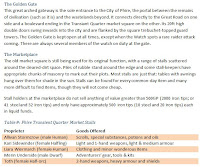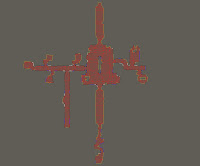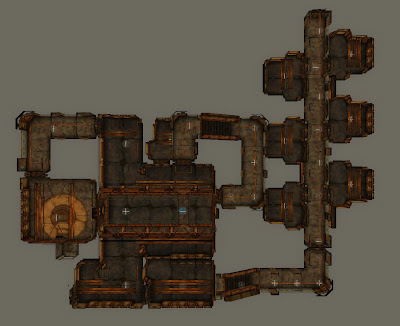Today's progress was filling in and completing the Transient Quarter of the City of Phire. Like I described in the
previous blog post, this involves an overview, the people, the places and story hooks (in that order). Today I will go into some detail about the thought processes behind the location's design and look at creating a location from the bottom up (starting with its mechanical purpose, leading through locations up to people). While I may fib a little about the order in which I completed the designs this is only for the purposes of making the logic clear.
The City of Phire is of such a size that to describe it in detail, corner to corder, would take forever to do all at once and be very confusing for both myself and any potential readers. A real city cannot think that way, either, and so city planners and inhabitants find ways to divide the concept of the 'city' into manageable regions: suburbs, districts, blocks and the like.
 |
Phire and Transient Qrter Overview
|
Which style of division depends upon how the city is formed. Many British cities are a series of suburbs surrounding a city centre because of the way European cities tended to grow from a single town until it encompassed neighbouring villages for miles around. American metropoli, however, we constructed or re-constructed with a Plan in mind so they have a grid system of horizontal and vertical roads at regular distances from one another (bar the occasional pattern-breaker like the Las Vegas strip).
The Sapphire City grew around the local centre of government, a palace built against the edge of the sea. As the city's wealth and population expanded, the stone-built areas expanded in only a few sudden, orchestrated phases of construction. Each time the city walls are extended around the new city limits and, inside, stone buildings are erected to suit the city planners' needs. Meanwhile the slums are pushed further out, beyond the city walls. This has resulted in a series of walled districts called Quarters. In world terms, each quarter has its own distinct historical use and cultural emphasis (a trade district has a lot of warehouses and merchant's offices, while the noble district has a lot of stately homes and ornamental for example). In terms of game mechanics, each district can be though of as analogous to a game level or zone. The Transient Quarter is home to vendors, quest givers, and maybe player housing, with encounters suitable for characters of level 1-5 (just as an example) while the Noble Quarter is a combat zone where quests usually lead and encounters tailored for characters of level 8-15 with regular loot and coin drops to match. That is not to say that the Falling Skies document describes them in such terms but hopefully I am making myself understood.
 |
| Places: Gateway and marketplace |
The Transient Quarter is designed with social interaction in mind. It should feel safe to the players and their characters while not losing the threat of danger all around. A sense of dread is important to a setting where people are regularly sent mad by scavenged artefacts and are eaten from within by corruption in the food they eat. With this in mind, the location design gravitates around three key points: the market square and the two gates which lead to the more dangerous Trade and Noble Quarters.
The gates are easily highlighted in a game by their very existence (as opposed to there being no wall and thus no clear barrier between zones) and the presence of guards that are not a large influence in the rest of the area. The market requires a little more work. First, the desired goods and services must be identified. In a small settlement you might have one trader that sells a wide range of common goods but only a little of each type of item, but in a larger town or city residents will require (and players will expect) several different traders specialising in particular kinds of stock. To fill this need I listed five different groups of items using headings from the Player's Handbook equipment chapter, each bullet point representing a different stall at the market.
But heroes can't get everything they need from market stalls so a few real structures were required: a smithy for the powerful weapons and armour they will need as they increase in experience, and a couple of inns to eat and sleep in (and in which to talk to shady hooded figures who sit in the corner staring into an empty glass). Any decent sized settlement requires
two inns or such to provide a choice for the discerning adventurer and to emphasise differences in social groups. A society with, if not conflict, at least friction between two sorts of people is far more interesting and fertile for adventure than one where everyone gets along. In the City of Phire the two groups served by the different drinking establishments are the common wasteland survivors who drink at the Sand Pit and the more wealthy and usually-magically-inclined crowd who frequent the Star of the East Hotel.
 |
| People: The Hotelier and the Shopkeeper |
Now we have the places, we need people to fill them. There are stalls in the market so stall-holders are required. There is an inn and a hotel so proprietors and bar-flies need creating. And what town would be complete without the criminal element? Rogues always need someone who talks on their level and, besides, writing crooks is a hoot.
An innkeeper, however, is never just an innkeeper. Well, yes, they are but you cannot think of them like that. Even if the only thing the character does is provide the heroes with beer and a bed, having a clear and... flavoursome character in mind when you portray the surly barkeep dragging their tips across the work-surface and shouting at a hireling to take the adventurers to their rooms will improve the sense of place and depth of the setting. So much better, too, if you avoid stereotypes and cliches in your characters. Yes, yes, sometimes a cliche is a cliche because it is so perfect for the role but you can usually get a better response from your players by providing them with fresh and interesting characters to play off against. When I found myself writing a Dwarf weapons and armour trader, an Elf magic goods seller and a Halfling rogues equipment distributor I had to shake my ideas around and force myself to work a little harder. Now the market place has a Dwarf selling adventurers gear, sandwiched between a Halfling light-arms seller and a Half-Orc woman who carries heavier weapons while the humans, one selling magic goods and the other alchemical items, verbally snipe across the square while resisting the urge to throw themselves into one anothers' arms.
See? Character! While I can't claim they will astound the world with their brilliance or originality at least I hope old archtypes have been shaken up and restyled into new and interesting forms that will be both relatable and novel to players' eyes.
Now I'm not sure I'm making sense any more as I am in dire need of some decent sleep so I will cut this short (hah!) and say goodnight for now. Tomorrow... well, we'll see what I get up to.
Goodnight.




































